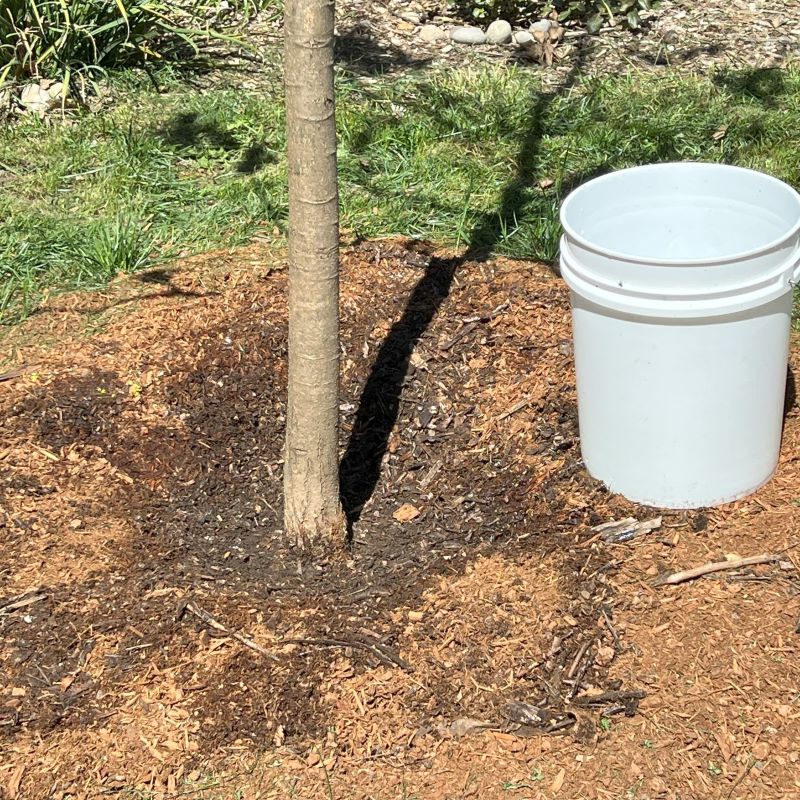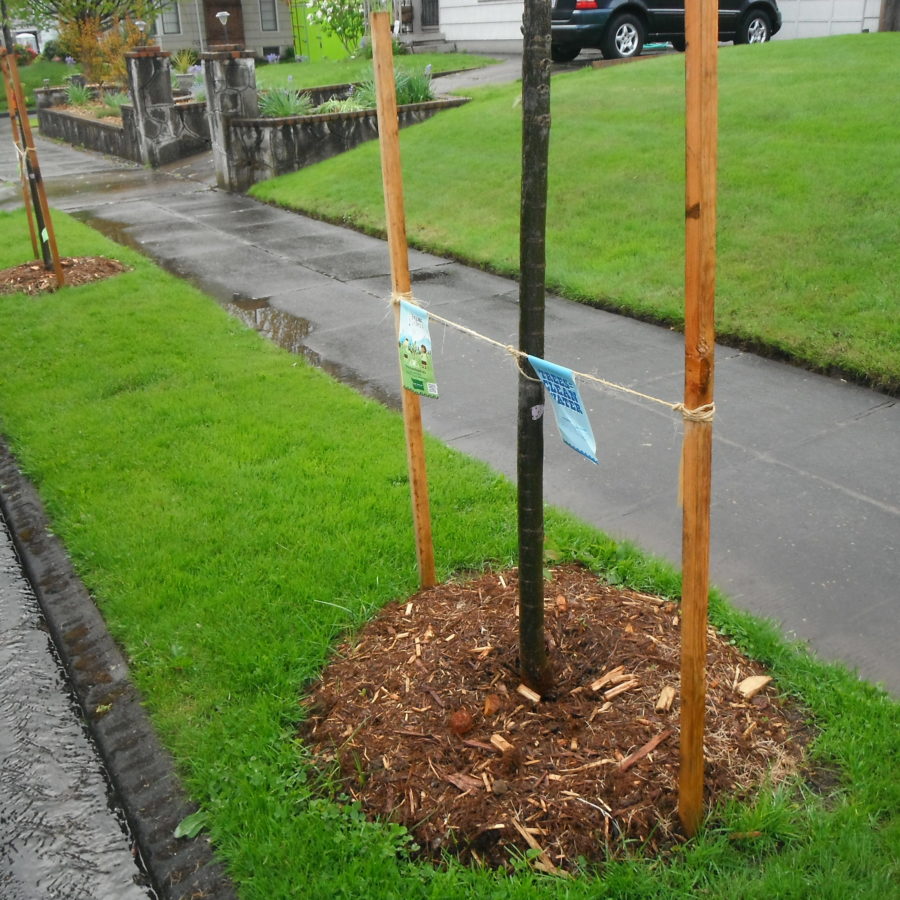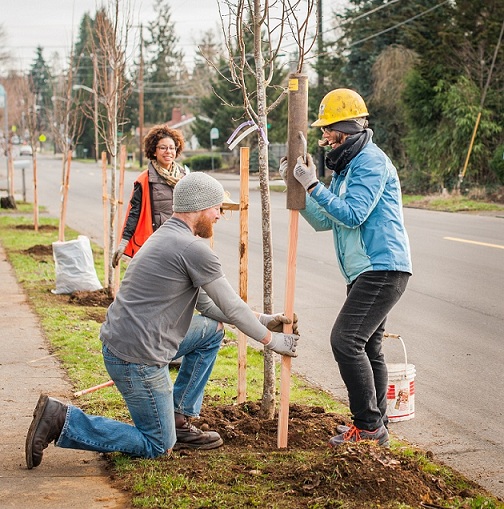Search Results for: the importance of mulching your tree
The Importance of Mulching your Trees

By Andrew Land
If you’re looking to learn far more about the importance of mulching trees than you knew before, then you’ve come to the right place! Other than watering, there’s arguably nothing better you could do to help your new tree get established than add a layer of mulch. Many think that mulch just makes newly planted trees look pretty, but the truth is that it serves several key functions all at once.
Before we even begin, what qualifies as mulch? The quick answer is that more or less any organic matter serves as mulch, from wood chips, to compost, to straw. Carbon is nature’s “sponge,” and in very general terms, organic matter that is brown (dry leaves, twigs, wood chips, straw) is primarily carboniferous and can hold available moisture to feed growing tree roots. In very hot climates, even rocks can be used to shade soil and make condensation available for tree roots, but rocks don’t do nearly as much in terms of imparting nutrition as organic mulches do.
For people, nutrients are either fat or water-soluble, but trees get all that they need from water. Mulches both hold that moisture for trees’ use and are arguably the best way to fertilize a young tree by providing slow-release nutrition that leaches down to the roots below with rain. Read More
Treemail: January 2020

|
Learn more about how Friends of Trees greens our region + grows community through checking out other issues of Treemail here https://friendsoftrees.org/news-resources/treemail.
Tree Care Guide
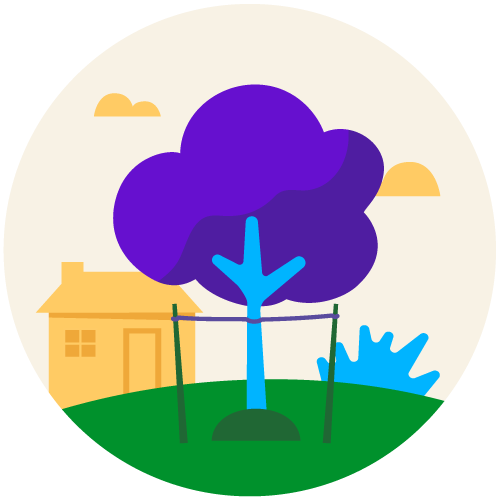
Congratulations on planting a new tree!
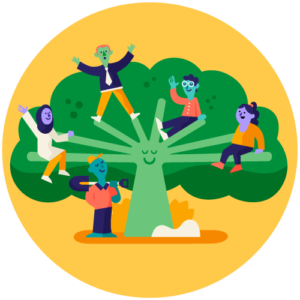
Watering
Trees need to be watered regularly during their first three summers after planting to survive. Water newly planted trees with 10-15 gallons of water once a week throughout the summer and during other dry spells. A dry spell can be characterized by two to three weeks without significant rainfall in the summer or winter.
Water slowly so that moisture soaks deeply into the soil and water doesn’t run away from the root zone. Mulching is a great way to hold water in the soil for your new trees. Our videos offer quick tips on how to use slow-drip watering systems such the five-gallon drilled bucket to water your trees more effectively.
Mulch
Mulch reduces evaporation, delivers organic nutrients, and helps prevent the growth of weeds. It is very important to mulch your new trees. Mulching prevents lawn mowers and string trimmers from getting close to the tree and damaging the trunk, which is the number two cause of tree failure. Mulching is second to watering in importance to the health of newly planted trees.
But be sure to pull the mulch away from the bark of the tree in a three-inch radius to prevent fungus growth or infection. Remember the 3-3-3 Rule: 3 inches away from the trunk of the tree, 3 inches deep, in about a 2-3 foot radius. Do not “Volcano Mulch” your tree by piling mulch up against the bark.
Removing Weeds & Grass
Keep all weeds, grass and other plants 18″ from the trunk of your new tree.
Weeds and grass in your tree’s root zone absorb water and nutrients that should be reaching the tree’s roots. They can greatly stress your new trees by creating a tougher establishment zone.
Removing weeds by hand reduces the risk of trunk damage from lawn mowers and string trimmers—a leading cause of urban tree failure.
Pruning
Properly pruning your tree is critical for its health and survival; below is a quick guide to pruning your tree. Interested in a more in-depth pruning guide? Visit our pruning page here.
Pruning basics
A young tree needs all the nutrition it can get from its leaves to develop strong roots, so during the first year after planting, only broken or dead branches should be pruned.
Sucker growth, young shoots growing from the base of the tree, should be removed at ALL times.
In the second year or third year, if the tree is growing well, structural pruning can be considered and is recommended. Street trees in the cities of Portland and Vancouver require a permit through Urban Forestry to prune.
There are several important keys to properly pruning young trees. Remember, you can always hire a certified arborist, and be sure to take a minute to check out these two great resources before you start pruning: Arbor Day Foundation’s Animated Pruning Guide and Ed Gilman’s Developing a Preventative Pruning Program: Young Trees. With proper structural pruning, your tree will truly become an asset, and living legacy, to the rest of the city.
Never top your tree
Topping is the indiscriminate removal of a tree’s branches to stubs and is perhaps the most harmful tree pruning practice known; yet, topped trees are still a common sight.
Not only does topping result in tree stress, decay, hazard and sunburn; it’s also ugly and expensive. Once you top a tree, you resign yourself forever to a maintenance treadmill as your tree rapidly declines and becomes increasingly costly to care for.
Have you recently planted a fruit tree? Here are the basics of fruit tree pruning.
Insects & Disease
Friends of Trees chooses trees based on their resistance to insect and disease, but if you think your tree has a problem, resources are available to help you find a solution.
Contact your local Extension office. The Cooperative Extension Service is a collaboration between the U.S. Dept. of Agriculture, state and local governments, and land-grant universities. Every U.S. county has an Extension office to deliver research-based information on gardening, agriculture, and pest control to the general public. You can find your local Extension office using a map on the website for the National Pesticide Information Center.
Ask a nursery. Bring a leaf or twig from your tree to your local retail nursery.
Hire an ISA-certified arborist. You can find a list of arborists certified by the International Society of Arboriculture who support Friends of Trees on our arborist page.
Friends of Trees does have ISA-certified arborists on staff, but as a non-profit, our time is dedicated to planting and establishing trees and we unfortunately do not have the capacity to spend the appropriate time to properly diagnose and treat insects and diseases.
Stakes & Twine
Keep your tree staked and twined for a year after planting to provide support during storms and to provide protection from foot traffic or car doors. After about a year, twine and stakes should be removed. Loosen any ties if they become tight around the trunk or begin to chafe away the bark. This can cut off the nutrient and water flow to the tree.
Feeling Stumped?
Feel free to give us a call at 503-595-0212 or shoot us an email at [email protected] with your question or a description of your problem, along with a photo and your street address. We’ll do what we can to help! You can also find a lot more information in these blog posts about tree care.
Didn’t plant your tree with Friends of Trees? We’d love to help, but as a non-profit our capacity is limited to supporting tree planters who participate in our planting program. We recommend contacting your municipality’s urban forestry department.
Four tips to help your young fruit tree thrive
Give your young fruit tree a little extra attention now and it will pay you back with a generous harvest for many years.
Here are a few tips:
- Start shaping a healthy branch structure now. The first season, scope out four to seven solid, lateral branches that will be your heavyweight fruit holders in years to come. The goal is to have evenly spaced branches, starting with the lowest one 2-3 feet from the ground and spiraling up the trunk 1-2 feet apart. This will let in sunlight to ripen fruit and dry off moisture, and allow air to circulate to prevent fungal diseases. Once you’ve selected your good branches, you can decide which competing branches to remove. Here’s a must-read article about pruning young fruit trees.

Strive for evenly spaced branches radially and vertically that will be your heavyweight fruit holders.
- Avoid common pruning mistakes. Number one is probably cutting too close to the trunk and injuring the tree at the branch collar. Here are some more pruning mistakes you can avoid.

Keep your pruning cuts away from the trunk, where you could damage the branch collar, where the healing hormones live.
- Mulch, mulch, mulch. A mounded doughnut of bark, compost or dried leaves will help your tree retain moisture and nutrients. We keep a free pile of mulch at our office! Here are more mulching tips.

Great mulch ring guys! - Clean up your fruit. After harvest season, try not to leave fruit on the ground over the winter, because that’s where a lot of pests can live.
If you want to dig a little deeper, check out upcoming fruit tree care workshops hosted by the Portland Fruit Tree Project. Happy harvesting!
3 ways (and free tools) to show a tree some love right now
 It doesn’t need a box of chocolates, a back rub or a hand-knit sweater (though that is pretty cute). But here are a few things you can do to show a tree some love this season:
It doesn’t need a box of chocolates, a back rub or a hand-knit sweater (though that is pretty cute). But here are a few things you can do to show a tree some love this season:
1. Treat it to a drink… of water, that is. During dry spells—we’ve had a few this winter—trees need 10-15 gallons of water per week. Here’s a video of how to hack a five-gallon bucket for an easy drip irrigation system.
2. Give it a warm blanket… of mulch—2 to 3 inches of compost, dried leaves or wood chips will do. Like a blanket, mulch regulates soil temperature to help roots establish and grow. It holds water in the soil and slow-releases nutrition for your tree as it rains. We maintain a pile of FREE mulch at our office, just come by and get some! Learn how to mulch
3. Set it up on a date… with an arborist. Even if your tree doesn’t need maintenance right now, you can establish a trusted relationship you can turn to down the road when you have questions about your tree. We recommend this list of Friends of Trees’ partner arborists to get you started.
Happy tree lovin’! Here are some more tree care basics














